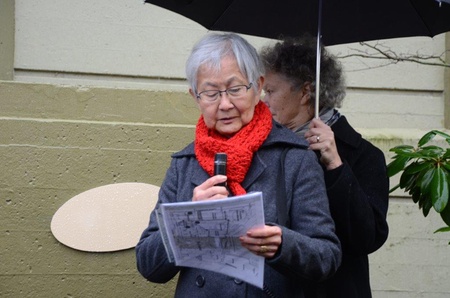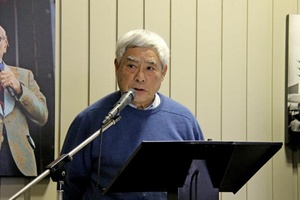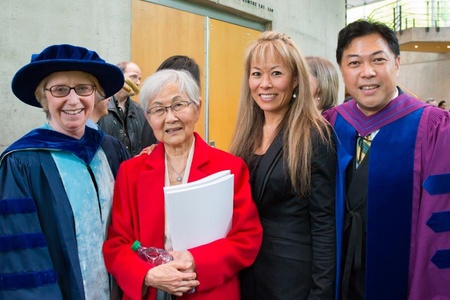Read Part 1 >>
When I was 48 years old, I went back to the University of British Columbia (UBC) to study the Japanese language and Asian Studies. There I met Professor Rene Goldman who encouraged me to write about my family’s experience during WWII. This was the beginning of my journey into telling the story of what my family had endured after Japan bombed Pearl Harbor.
Professor Goldman encouraged me to write about the internment and to speak about it whenever opportunities arose. I began speaking at conventions, conferences, workshops, schools, community events, universities etc. At first it was very difficult. I did not realize how much pain of the experiences of my parents and grandparents was buried within my psyche. Now after countless presentations, I have been freed from the pain.
Until the GVJCCA (Greater Vancouver Japanese Canadian Citizens’ Association) Human Rights Committee got involved in my family’s struggle with racism on Salt Spring Island, Tosh and I did not have any connection with the Japanese Canadian community.
We were the only non-white family when we moved to Tsawwassen in 1968. Our two children encountered many racist incidents for quite a while. They had never faced racism before so at first it was very confusing to them. It was difficult for my son because he was physically attacked a lot. Slowly some Asian families began to move in so the community is now more accepting of different racial groups. However, Tsawwassen is still a white community.
We joined the Human Rights Committee soon after and became active members. During the 20 years that we were members, there was an ebb and flow of people who joined and left the committee. The successes that we achieved were important to the JC community.
‘Honouring our People’ conference gave voice to internment survivors who remained silent until then. A book about the conference is being published soon. It will include the participants’ stories, the JC history, photos, description of the internment centres, the road work camps, POW camps, and a DVD.
By selling donated greenhouse vegetables at the Powell Street festival, Tosh and I earned enough money for the Human Rights Committee to function. When it became too physically taxing, we stopped selling the vegetables.
Tosh introduced ‘Spam sushi’ to the Powell Street Festival crowd. It was an immediate success. He contacted Hormel Foods for donation of the Spam. They are continuing to be generous with their donation of Spam, aprons, posters and equipment. Earlier this year, Tosh and I decided to leave the Human Rights Committee in order to spend more time with our family; five grandchildren and two great granddaughters. However, we intend to help out with community events such as the Powell Street Festival whenever we are able. We left our involvement with the Hastings Park project and the Reverend G. Nakayama projects.

Reading the words on the plaque placed on the wall of the agricultural barn at Hastings Park (2013). It is one of the "Places that Matter"
Community is wherever we live. My grandparents and parents always were conscious of the needs of people within their community. They contributed to the welfare of people and organizations that needed their help. My parents would always give more than they received.
Often different types of gifts were left at our door at night because people said that they could never “out give” my parents otherwise. This attitude of giving and contributing to other’s needs was passed down to us.
Although my family suffered virulent racism on Salt Spring Island after we returned in 1954, my brother Richard and sister Rose donated a piece of commercial land that was worth $1.4 million and built a 27 unit $6 million low income housing complex for people who could not afford a place to live. Their generosity and caring for people who needed help is a symbol of forgiveness to a community that once betrayed them.
Mahatma Gandhi once said that the weak can never forgive, that forgiveness is an attribute of the strong. When growing up I heard the word, ‘forgive’ constantly. My parents stressed the nobility of forgiveness in order to move on with life. The word, bitterness was never part of their vocabulary.
They were future oriented and lived each day looking forward to a better tomorrow. Even when they were physically incarcerated during the internment, their minds were never controlled by those who put them there. When I think of my parents, I think of William Earnest Henley’s poem, ‘Invictus’ where he states in part, “I am the master of my fate: I am the captain of my soul”. My parents’ always had control of their mind and soul.

At the reception after the placing of the plaque on the barn at Hastings Park. Tosh is reading the message from the NAJC.
Ours was called the “silent” generation that failed to pass on the experience of what happened to the lives of Japanese Canadians during World War II.
My parents were never silent. They believed in discussing many topics with their children. During our childhood, they always discussed the reality of our situation with us. We heard them talk about the racist BC politicians who were responsible for the decision to incarcerate the 22,000 Japanese Canadians from the coast. Because as a child, I heard the names of those politicians so many times, it remained embedded in my memory.
In the September 13, 2006, Vancouver Sun newspaper, I read a long article about an ‘environmentally friendly’ Federal building having been named after Howard Charles Green. That name triggered something deep in my memory. When I realized who he was I sent a friend to the Vancouver Public Library where he found countless newspaper headlines highlighting Howard Green’s vitriol against Japanese Canadians.
I sent a letter to Michael Fortier, Minister of Public Works who had come to Vancouver for the ceremony to honour Howard Green, to inform him of the inappropriateness of their choice. I asked him why the Conservative Government, who in 1988 had apologized to the Japanese Canadians by redressing the wrong, was honouring the man who led the charge to destroy our lives? It took about a year to convince him to replace the name.
Grace Eiko Thompson, Roy Miki and I presented our case to the naming committee as did the Howard Green family. The building at 401 Burrard Street was renamed, the Douglas Jung Building. There was a lot of opposition to the name change, but I was determined have it removed. No one who destroyed my parent’s dream was going to be so honoured.
One of the most gratifying experiences of my life was getting UBC to honour the 76 Japanese Canadians students who were expelled in 1942.

After the ceremony with Dr. Sally Thorne Chair of the UBC Senate Tributes Committee, our daughter Karen Bennett and Dr. Kerry Jang professor of psychology and Vancouver City Councilor.
The journey of four years to convocation was frustratingly long. It was fraught with many challenges that required me to be stubbornly persistent. I was not going to have those students betrayed again. In the end, the result brought much joy to the students, their families and our community.

After the ceremony with Margaret Hasegawa whose husband died 13 days before the ceremony, Tosh and Dr. Henry Yu Professor of History who will be teaching the new Asian Canadian and Asian Migration minor course starting September 2014.
The special convocation was the first part of the three prong program voted on by the UBC Senate. The second prong which I think is very significant is the initiative to educate future UBC students about the history of Japanese Canadians. In order to do this, a new Asian Canadian Studies and Asian Migration minor course is being offered, beginning in September of 2014. It was made a minor in order to allow students from all other faculties to access it.
The third prong now insures that our history will be preserved and brought to life by having it digitized by the UBC library. Our community will be constantly consulted as the new course continues to evolve. The interviews of the 1942 students and other surviving elders in our community are important sources that will help the present and future UBC students to understand how Japanese Canadians dealt with racism and injustices they faced.”

With some of the people who worked on the tributes committee that produced the May 30, 2012 convocation for the 1942 JC students.
© 2014 Norm Ibuki







